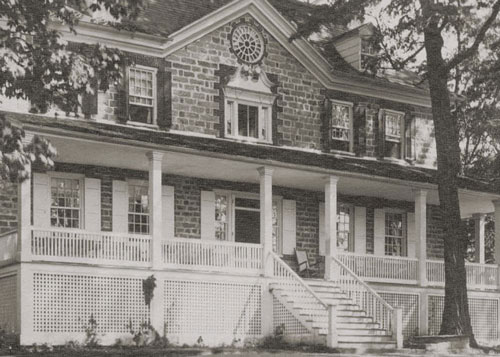Weatherstone
At the south end of Sharon’s Main Street stands a venerable building deeply entrenched in the history of the Colonial-era town. Built between 1765 and 1777 by Simeon Smith, this large stone house was the home of the extended Smith family until 1915.
The house was first designated as the Governor Smith Homestead after its third owner, John Cotton Smith, who graduated from Yale in 1783 and practiced law in Sharon. A member of the state House of Representatives and the U.S. Congress, he became the Governor of Connecticut in 1812.
Since 1938 his former residence has been called Weatherstone. It is speculated that Noah Webster wrote some of his Blue-Backed Speller (later known as the Merriam-Webster Dictionary) in this home when he was a guest of the Smith family.
Simeon Smith, a prominent doctor, pharmacist and Revolutionary War militia leader, had the two-and-a-half-story stone building constructed with locally quarried stone. The stonework was supposedly overseen by an Italian craftsman brought in by Smith. Smith conducted a meeting at the house in 1779 of several other medical professionals which they styled as the first meeting of its kind in the new United States.
Its oldest portion is the rear ell which was occupied while construction of the main block continued. But finishing elements on the house were delayed by the American Revolution and the patriotism of the Smith family may well have led to Simeon losing possession of the structure.

Records show that he raised a company at the beginning of the war, equipped it at his own expense and led it as a captain in Washington's army at New York and Long Island. He raised another company for the Burgoyne Campaign but, breaking his leg, was unable to command it.
Governor Trumbull further called on him to supply the Connecticut troops with necessary supplies of powder, saddles, horse shoes, clothing, blankets and stores of grain and cattle. His sacrifices of time, energy and of his own means drained his estate and Smith fell on hard times financially after the war. He was forced to turn the property over to his esteemed minister brother, Cotton Mather Smith, who settled some of his debts.
Cotton Mather Smith was also an ardent patriot who is said to have dismissed his congregation following the morning service in April 1775 when word arrived in Sharon of the Battle of Lexington. One hundred men gathered on the village green prepared to march to Boston. He served as chaplain in the army from 1775-76 under General Philip Schuyler.
His son, Governor John Cotton Smith, inherited the building from his father after Cotton Mather Smith’s death in 1806.
Simeon Smith moved to West Haven VT and recovered his wealth before his death in 1804. He built a second mansion there and both his homes have been listed on the National Register of Historic Places.

